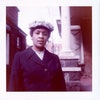The opening section of Susan Sontag’s 1992 novel, The Volcano Lover, finds its author hesitating, at once skeptical and expectant, at the entrance to an
A Polaroid picture found by the author at the Chelsea Flea Market, New York.
Long before there was a booming market for “vernacular” pictures, savvy collectors (notably, Mapplethorpe mentor Sam Wagstaff) recognized the art in supposedly artless, anonymous photographs. Thomas Walther, whose extraordinary collection of mid-century European avant-garde photography was acquired by New York’s Museum of Modern Art, searched out flea market pictures with the same skewed, startling, antic, or lyrical qualities he prized in André Kertész, Aleksandr Rodchenko, and Man Ray. When Walther’s vernacular “Other Pictures” were framed and put on display at the Metropolitan Museum in 2000, they made it clear that eccentric, experimental modernism is in the eye of the beholder and true connoisseurship knows no bounds. For collectors at all levels–amateur to pro–flea markets have always been great places to educate the eye. Even if you’re not concerned with pleasing anyone but yourself, you learn how to do that better, with more focus, more care. Lately, with this column in mind, I’ve been paying more attention to pictures of women who have dressed up for work, or church, or shopping with friends. Inevitably, they’re fashion photographs and all the more engaging because they weren’t made for public consumption. The woman in the photograph here, in her pearls and her petal-strewn hat, is charmingly formal in an informal setting. Whether she’s leaving for morning services or lunch at her club, she looks poised and expectant–ready for her close-up, but anxious to step out into the world.
Vince Aletti is a photography critic and curator. He has been living and working in New York since 1967. A contributor to “Aperture”, “Artforum”, “Apartamento” and “Photograph”, he co-wrote “Avedon Fashion 1944-2000”, published by Harry N. Abrams in 2009, and is the author of “Issues: A History of Photography in Fashion Magazines”, published by Phaidon in 2019.

